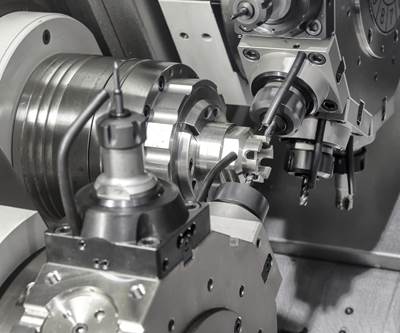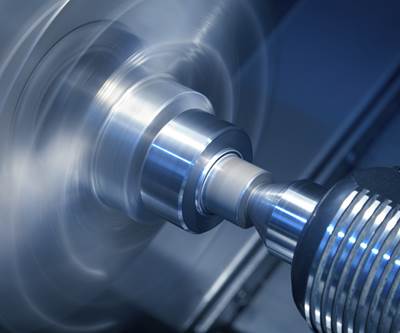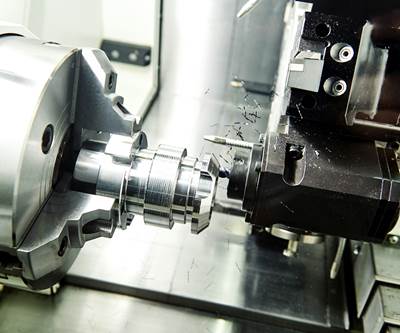Buying a Lathe: The Basics
Lathes represent some of the oldest machining technology, but it’s still helpful to remember the basics when considering the purchase of a new turning machine.
Share




This blog post is adapted from an article that appeared in the February 2018 edition of the Machine/Shop print supplement to Modern Machine Shop.
One of the key characteristics of a lathe, unlike a vertical or horizontal milling machine, is that the workpiece turns, as opposed to the tool. Thus, lathe work is often called turning. Turning, then, is a machining process used to make round, cylindrical parts. Lathes are commonly used to reduce the diameter of a workpiece to a specific dimension, producing a smooth surface finish. Basically, the cutting tool approaches the rotating workpiece until it begins peeling away the surface as it moves linearly across the side (if the part is a shaft) or across the face (if the part is drum-shaped).
Very few lathes today are not controlled by a CNC, although you can still buy a manually controlled lathe. When equipped with means for changing tools out automatically, such as with a tool turret, the CNC lathe is more properly called a turning center. CNC turning centers are available in a wide range of sizes and capabilities, from simple two-axis lathes, which move in only X and Y, to more sophisticated, multi-axis turning centers capable of handling complex four-axis turning operations, milling, drilling, tapping and deep-hole boring — all in one operation.
Basic Lathe Configuration
The basic two-axis lathe consists of a headstock with spindle, chuck for holding the part, lathe bed, carriage and cross-slide, tool turret and tailstock. While most lathes have a moveable tailstock to support the workpiece at the end, away from the chuck, not all machines come with this feature as a standard. A tailstock is particularly useful, however, when the workpiece is relatively long and slender. Failing to use a tailstock in this case can cause “chatter,” which leaves telltale marks on the surface of the part. Unsupported, the part itself can become tapered, because it may bend excessively from tool pressure while being cut.
When considering adding a tailstock as an option to a lathe, pay attention not only to the current job being run, but also the size of future work. When in doubt, include the tailstock with the initial machine purchase. This recommendation will likely save the headache and expense of installing one later.
Machine Specifications
Regardless of how many axes of motion are required, in evaluating the purchase of any lathe, a shop must first consider the size, weight, geometric complexity, required accuracy and material of the parts being machined. The expected number of parts in each batch also should be taken into account.
Common to all lathe purchases is the question of the size of chuck to hold the intended parts. For turning centers, chucks generally range in capacity from 5 to 66 inches in diameter, or even larger. When parts or barstock must extend through the back of the chuck, maximum spindle through-hole or barstock capacity is important. Machines designed with “big-bore” options are available if the standard through-hole size is not large enough.
The next critical spec is the swing diameter, or maximum turning diameter. This figure indicates the largest-diameter part that could fit in the chuck and still swing over the bed without hitting. Equally important is the maximum turning length required. This workpiece dimension determines the necessary bed length of the machine. Note that maximum turning length is not the same as bed length. For example, if the part being machined is 40 inches long, the machine bed will need to be much longer to effectively turn the full length of that part.
Finally, the number of parts to be machined and the required accuracy are prime factors for specifying the capability and the quality of the machine. Machines for high production call for high-speed X and Y axes, with rapid-travel rates to match. Machines for close-tolerance work are designed to control thermal drift in ballscrews and key components. The machine structure may also be designed to minimize thermal growth.
This is part one of a four-part series about buying turning machines.
- Part 2: Buying a Lathe: Turrets and Live Tooling
- Part 3: Buying a Lathe: Spindles and Tailstocks
- Part 4: Buying a Lathe: Slant-Beds and Multitasking Configurations
Find more insights about acquiring a new machining center by visiting the Techspex Knowledge Center, “Guide to Buying Machine Tools.”
Related Content
Addressing Manufacturing Challenges with Automation
GrayMatter Robotics’ Physical AI robotic cells for manufacturing offer immediate impact and results.
Read MoreWhere Micro-Laser Machining Is the Focus
A company that was once a consulting firm has become a successful micro-laser machine shop producing complex parts and features that most traditional CNC shops cannot machine.
Read MoreShoulder Milling Cuts Racing Part's Cycle Time By Over 50%
Pairing a shoulder mill with a five-axis machine has cut costs and cycle times for one of TTI Machine’s parts, enabling it to support a niche racing community.
Read MoreHow to Determine the Currently Active Work Offset Number
Determining the currently active work offset number is practical when the program zero point is changing between workpieces in a production run.
Read MoreRead Next
Buying a Lathe: Slant-Beds and Multitasking Configurations
What are some variations on the basic lathe configuration? This can be helpful to review when considering the purchase of a new turning machine.
Read MoreBuying a Lathe: Spindles and Tailstocks
A key consideration when buying a new turning machine involves its spindle. Here’s an overview of what you need to know.
Read MoreBuying a Lathe: Turrets and Live Tooling
When buying a lathe, after considering what sorts of workpieces the machine must be prepared to handle, it’s time to ponder tooling options.
Read More



























